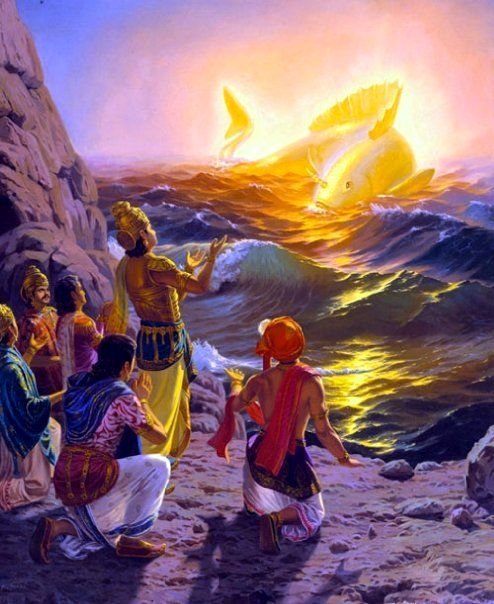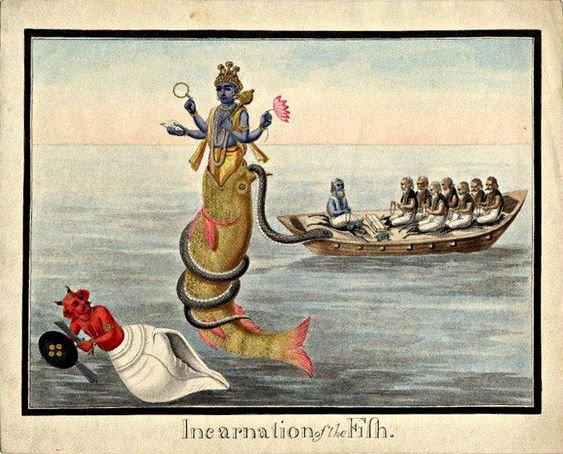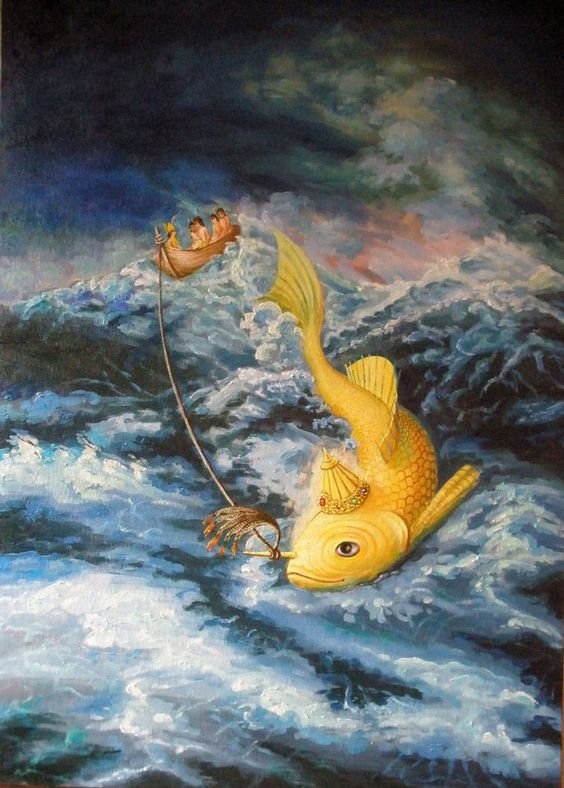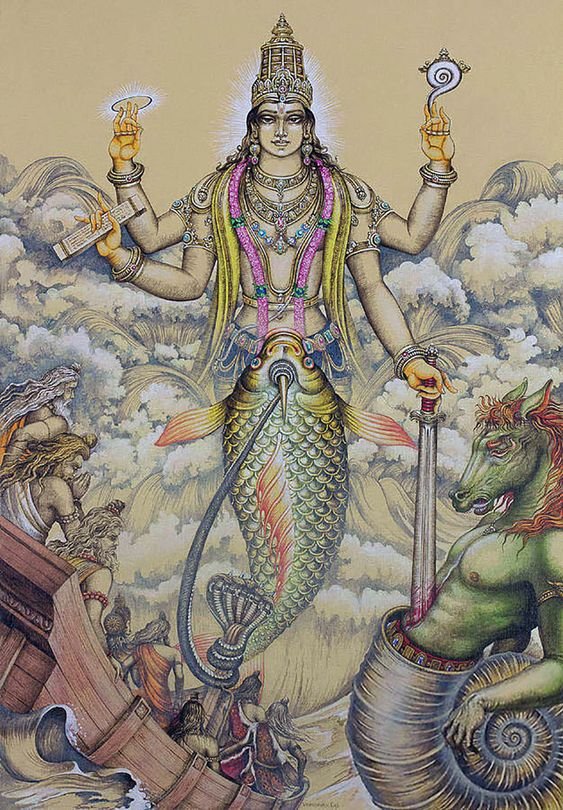Exploring the Origins of The Matsya Purana: The First Avatar of Vishnu

One of the 18 Mahapuranas in Hindu Literature, the Matsya Purana is among the most important and oldest writings. It revolves around the story of Lord Vishnu’s first incarnation, the Matsya (fish) avatar, as the name implies. Cosmology, geography, religious ceremonies, building temples, and the responsibilities of rulers are only a few of the many subjects covered in this Purana. It is regarded as a thorough manual for various aspects of life in addition to being religious and mythological literature.

History
The chronology of the Matsya Purana, just like that of all Puranas, is rather complicated. It is challenging to determine the time, place, reason, and authorship of the Puranas due to their encyclopaedic approach. While some academics and scholars say that it had been composed before the 3rd century CE, some say it dates between c. 200 and 500 CE.
This work of literature is titled after Matsya, the Hindu god Vishnu’s fish avatar. The Matsya Purana is divided into two halves in Tamil: Purva (early) and Uttara (later). It comprises 172 chapters. There are 291 chapters in other published versions of the Matsya Purana manuscripts. Containing over 14,000 verses, the text provides a wealth of knowledge about various aspects of Hindu religion, art, and culture.

Mythology
King Manu and Matsya avatar
King Manu, the first man according to Hindu mythology, was performing penance when he saw a small fish in his hand. The fish wanted to be protected from larger animals, so Manu put it in a water jar. The fish grew rapidly and eventually outgrew the jar, so Manu moved to a larger jar, then to a pond, and finally to the ocean. Manu then realized that the fish was no ordinary creature, but an incarnation of Vishnu. This incarnation told the king of an upcoming flood that would endanger humanity. He instructed Manu to build a ship and take with him one of every species, along with the sacred scriptures, to preserve life and knowledge during the flood. When the flood came, Vishnu in the form of a fish steered the boat with a huge serpent rope tied to his horns. He Recover the stolen Vedas and safely restored them. Matsya hance ensured the preservation and enrichment of knowledge and life.

The story of Savitri and Satyavana
Savitri, a princess of great beauty and intelligence, chose Satyavana, a simple but virtuous prince living in exile with his blind father, as her husband. However, she was warned by the sage Narada that Satyavana was destined to die one year from their marriage. As the fated day of Satyavana’s death approached, Savitri began a rigorous penance and fast for three days and nights. When Yama, came to claim Satyavana’s soul, Savitri followed him, refusing to leave her husband’s side. Impressed by her devotion, Yama offered her any boon, except for Satyavana’s life. Savitri, using her wisdom, requested boons that would eventually lead to the restoration of her husband’s life. She asked first for her father-in-law’s eyesight and kingdom to be restored and, lastly, for the blessing of having many children with Satyavana. Yama, moved by her loyalty, granted all her requests, including restoring Satyavana to life.

Story of Tarakasura
Tarakasura was a powerful demon who earned a boon from Brahma, granting him invincibility, with the exception that only a son of Lord Shiva could kill him. Confident that Lord Shiva, deep in meditation after the loss of his wife Sati, would not remarry. Tarakasura became very confident that there would be no threat for his life, he then went on created a havoc on the gods and the world. The gods eventually had to intervene, leading to Shiva’s marriage to Parvati and the birth of Kartikeya, who ultimately defeated and killed Tarakasura in battle, ending his reign of terror. This is also one of the stories that were also mentioned within the purana.

Worship
In numerous instances, Visnu has been recognized as the Supreme Being by the Matsya purana. The Matsya purana states that Lord Visnu is the deity who combines the three roles of world creation, nutrition, and annihilation. In addition to destroying creation for enjoyment, Lord Visnu embraces the universe and maintains it with sattva. The creation of the three realms by Lord Visnu and their subsequent destruction by His wrath are also mentioned in the 248th chapter. He is credited with creating not just the universe but also Brahma.
According to this purana, it is substantiated that Lord Visnu is the centre of the universe. He is the universe’s sustainer. He is in charge of everything, including the devas. Various chapters can be seen delving into the shiva and devi cult.

It emphasizes the importance of bhakti (devotion) in achieving moksha (liberation). It prescribes several rituals and practices for worshiping Vishnu. This includes reciting his names, offering flowers, lighting lamps, and making food offerings. Worship of Other Gods alongside Vishnu, the Matsya Purana outlines methods for worshiping Shiva, Durga, and Brahma. The Purana prescribes daily rituals, festivals, and special prayers to please these deities.
Scientific aspects of the purana
Temple construction
Like many other Puranas the Matsya purana has also broadly discussed about the temple architecture. The Hindu temple architecture deployed perfect geometric shapes such as circles and squares. As temples are connected with religion and religion is one of the basic social elements that influence the society in a spectacular manner, temples remained the storage of important information all along. It also says at the time of starting the construction, celebrations should be held with dancing, playing music.

Cosmology and Astronomy:
Like other Puranas, the Matsya Purana provides details about the creation of the universe, the division of time into cosmic ages (Yugas), and the structure of the cosmos. It speaks about the different Lokas (worlds) and realms of existence, illustrating the ancient Hindu understanding of the universe.
Geography:
The text also provides geographical descriptions of ancient India and the known world, including the locations of rivers, mountains, and sacred places. In Matsya Purana, the terms caturdvīpī bhūgola and saptadvīpī bhūgola refer to two distinct ideas of the bhūvanakoṣa, or geography of the globe. The first is based on the four dvīpas, in which Mount Mahāmeru is depicted as a part of a lotus-shaped earth. According to this concept, the earth was shaped like a lotus. Mount Mahāmeru is the centre of the earth forming the pericarp of the four petalled lotus. The idea of saptadvīpā or “earth with seven dvīpas,” is another mentioned here.

Legacy
The legacy of the Matsya Purana is vast, having influenced both religious practices and cultural developments in India for centuries. Its teachings on bhakti, temple construction, and social duties have left a lasting mark on Hindu society. Temples dedicated to Vishnu, especially those depicting his Matsya avatar, are found across India, testifying to the enduring influence of the Purana.
The Purana also played a role in preserving cultural heritage through its discussions on history, kingship, and morality. It continues to be a vital part of Hindu religious discourse and practice. Additionally, its instructions on Vaastu Shastra have shaped the construction of homes and temples, influencing Indian architecture even in modern times.

Conclusion
The Matsya Purana holds a unique place in Hindu tradition. It combines mythology, religious instruction, and practical guidance on topics like architecture and geography, making it a comprehensive guide. Through its emphasis on bhakti, worship, and temple construction, the Matsya Purana encourages followers to live a life of devotion and righteousness. Its rich content ensures that it remains a vital text within Hinduism, continuing to inspire and guide devotees even today.


